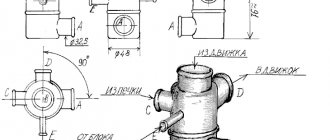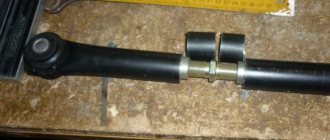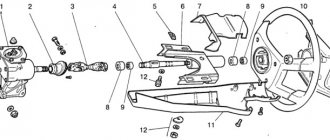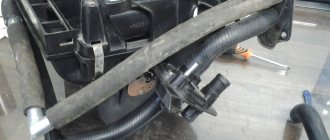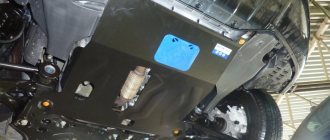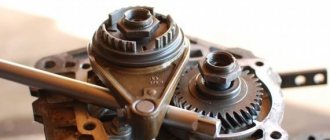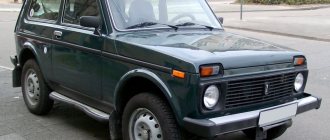What is a thermostat for?
The thermostat is necessary to maintain the coolant temperature within the operating range. In simple words, a thermostat is a valve that shuts off and opens the flow of coolant through the cooling radiator.
The operating temperature of the engine is from 80 to 95 degrees, this temperature is considered normal, and a working thermostat maintains exactly this coolant temperature. When the thermocouple is faulty, the temperature becomes less or much more than expected, which can even lead to engine failure.
Instructions for a complete diagnosis of the starter
The starter does not transmit torque to the crankshaft
| Diagnostics | Possible reasons | Remedy |
| When trying to start, a constant noise is heard, the starter clicks, the voltage at the battery terminals is less than 12V | The battery is low | Charging the battery |
| The voltage readings at the battery terminals are normal; when starting the starter, a crackling sound is heard with the voltage dropping twice | Decrease in battery capacity | Slow charging of the battery with a current of no more than 1A |
| During startup, a crackling sound is heard; when measuring the wiring from the battery to the starter with a voltmeter, a voltage drop of more than 1V was detected | Oxidation of battery terminals or starter terminals | Cleaning terminals, treating with anti-corrosion compound |
| Inspection of flywheel gears, drive shaft, bendix on a dismantled starter | Worn or broken teeth on the flywheel or shaft drive gears | Replacing the flywheel or a new starter |
| Failure to operate the solenoid relay when the 12V wiring is running at its contacts | Breakdown of the solenoid relay, damage to the wiring on the contacts, oxidation of the relay terminals | Replacing the relay with a new one, or cleaning the contacts and eliminating broken wiring |
| When 12V is supplied to the relay, no click is heard, the starter turns off | The relay is faulty, breaks in the armature winding, contamination or moisture ingress into the commutator, short circuit | Replacing the relay, cleaning the internal components of the starter |
| The starter drive rotates slowly when the relay is operating, the starter is turned off | Wear of the brush assembly, burnout of the commutator winding or armature | Replacing brushes, cleaning the commutator, or replacing the starter |
| When the starter starts, the drive armature rotates, but the flywheel remains stationary | Drive coupling wear | Replacing the clutch or starter with a new one |
| When the ignition is turned on, a grinding noise is heard, the drive shaft rotates, but the flywheel and crankshaft remain in place | Worn gear on flywheel | Flywheel replacement |
| The starter armature does not rotate when the relay is running | Breakage or burnout of the armature winding | Replacing the starter with a new one |
Activation of torque on the starter without starting the engine
| Diagnostics | Possible reasons | Remedy |
| Visual inspection of the starter at the mounting points | The starter mounting bolts on the engine are loose | Tighten the threaded connections, replacing the bolts with new ones if necessary. |
| The starter is inspected in disassembled form | Loose terminal contacts on the armature | Tighten the nuts on the terminal contacts, having previously cleaned them |
| The starter is inspected in disassembled form | Worn bushings, damaged drive bearings | Starter replacement |
| When starting, the bendix rotates, the flywheel rotates slowly, the engine does not start, a loud noise is heard | Breakage of teeth, wear of flywheel gears | Flywheel replacement |
| The starter continues to operate after turning the key back in the ignition switch | Malfunction of the ignition switch, weakening of the reverse buffer spring, malfunction of the traction relay | Replacing the contact ignition unit, replacing the relay or spring on the reverse clutch |
| Slow rotation of the starter without starting the engine with extraneous noise and good wiring | Malfunction of the crankshaft, oil thickening at low temperatures, failure of the piston group system, generator failure | Diagnostics and maintenance of cylinder-piston mechanisms |
| The starter operates at increased loads without starting the engine | Insulation in high-voltage wires is broken, voltage surges in the circuit, short circuits | Diagnostics and repair of electrical wiring |
Symptoms of a problem
You can judge whether the thermostat is malfunctioning by finding signs of a malfunction in your car, such as insufficient coolant temperature, that is, when driving on the highway or in the cold season, the antifreeze temperature begins to drop rapidly or does not rise to operating temperature at all.
- The engine does not heat up to operating temperature;
- The engine overheats and constantly boils;
- Insufficient heating of the internal combustion engine during the cold season (cold air blows from the stove);
It should be noted that if the engine overheats, the reason may be not only the thermostat, but also the breakdown of the water pump blades.
Reviews from Chevy Niva owners
Alexey Bondarenko, Kazan
For a year now I have been driving with a WEEN thermostat, article number 181-0034. The device turns on at a temperature of 87°C. My first thermostat was also a WEEL brand. I traveled with him for less than a year. He stopped maintaining his temperature. I've had my current device for one year and a summer. There were never any problems. The temperature always stays between 85-92 degrees.
Maxim Kalashnik, Pskov
I have been operating a VAZ Chevrolet Niva for more than 10 years with a Thomson thermostat. I have no complaints about the thermostat. Its peculiarity is that thermal inserts work for about 2 years in normal mode. Then they begin to underestimate their indicator. The standard temperature for them is 81°C. In the summer they work fine, that is, 87°C, and in the winter it feels a little cool at 81°C.
Sergey Poltorak, Bologoe
Finnord installed it on the previous Shniva, it worked 100%, last year it started to freeze on the new Shevik, but I couldn’t find Finnord, I installed Luzar - not cold but not so hot either...
Examination
The check can be done without removing the part from the car. To do this, start the cold engine and wait until it warms up to operating temperature. During warming up, we touch the lower radiator pipe several times and evaluate its temperature. Before the car reaches operating temperature, the lower pipe must be cold; if it warms up at the same rate as the other pipes, then the thermostat is faulty and is stuck in the open position.
Articles and prices
To make it easier for you to decide which one is best to install on your car, the table below shows the article numbers and prices for the previously discussed models.
| Model | vendor code | Price, rub |
| Thomson | TA2123-1306010 | 390 |
| Zommer | 2123-1306010-06 | 420 |
| Metal Inkar (polyamide) | 10.0300.01 | 515 |
| Pramo | 2123-1306010-02 | 600 |
| WEEL | 181-0034 | 630 |
| Luzar | LT0123 | 605 |
| Herzog | HL36010 | 520 |
| Vkt | VT29003 | 480 |
| Fenox | TS009E7 | 490 |
| Finord | 21231306010 | 510 |
| Baker | 21231306010 | 450 |
| Finwhale | FinwhaleT123 | 520 |
| Gallant | GLTH14 | 500 |
| Hofer | HF 445 730 | 550 |
Types of thermostats
The standard Niva thermostat is a fairly reliable element and serves faithfully for a very long time. The opening temperature of the factory thermoelement is 85⁰С, which is not enough for the stove to operate efficiently in cold weather. There are a huge number of analogues of the factory thermostat, and one of them is a thermocouple with a large circle opening temperature of 92⁰C, which will allow the internal combustion engine to operate at higher temperature conditions and will make the interior heater work much more efficiently, which will not affect the operation of the internal combustion engine.
Manufacturers and types
Standard sizes of thermostats, which by their design are suitable for installation in the engine of a Chevrolet Niva car, are produced by a number of global companies. The table below presents a list of products.
| Model | Product serial number | Opening temperature |
| Thomson | 21230-1306010-05-0 | 80° |
| Zommer | 2123-1306010 | 80° |
| Metal Inkar | 2123-1306010-01 | 80° |
| Pramo | 2123-1306010-02 | 80° |
| WEEL | 182-0114 | 80° |
| Luzar | LT0123 | 80° |
| Herzog | HL36010 | 80° |
| Vkt | VT29003 | 80° |
| Fenox | TS009E7 | 80° |
| Finord | 21231306010 | 80° |
| Baker | 21231306010 | 80° |
| Finwhale | FinwhaleT123 | 80° |
| Gallant | GLTH14 | 80° |
| Hofer | HF 445 730 | 80° |
There is an opinion among car owners that the highest quality, reliable and durable thermostats are products produced by Russian factories. There are currently three such enterprises:
- City of Stavrovo, Vladimir region, ATO plant;
- City of Rzhev, Tver region, PRAMO plant;
- City of Vladimir, Thomson LLC.
Among foreign models, car owners have good reviews of the Metal Inkar model from the Polish manufacturer.
These products work great in the Chevrolet Niva cooling system, the engine warms up quickly, there are no complaints.
The only negative is that the body is made in two versions - plastic and brass. The second option is not very popular among drivers, although it also works well in a circuit.
Why does the thermostat fail?
Failure is possible due to long-term use of coolant without replacing it. Since during heating and cooling, various chemical reactions occur inside the system, which cause both corrosion and various precipitation. The resulting debris passes through the thermostat, causing corrosion and contamination on it, causing it to jam.
It is recommended to change the coolant at least once every 3 years.
The starter does not transmit torque to the crankshaft
| Diagnostics | Possible reasons | Remedy |
| When trying to start, a constant noise is heard, the starter clicks, the voltage at the battery terminals is less than 12V | The battery is low | Charging the battery |
| The voltage readings at the battery terminals are normal; when starting the starter, a crackling sound is heard with the voltage dropping twice | Decrease in battery capacity | Slow charging of the battery with a current of no more than 1A |
| During startup, a crackling sound is heard; when measuring the wiring from the battery to the starter with a voltmeter, a voltage drop of more than 1V was detected | Oxidation of battery terminals or starter terminals | Cleaning terminals, treating with anti-corrosion compound |
| Inspection of flywheel gears, drive shaft, bendix on a dismantled starter | Worn or broken teeth on the flywheel or shaft drive gears | Replacing the flywheel or a new starter |
| Failure to operate the solenoid relay when the 12V wiring is running at its contacts | Breakdown of the solenoid relay, damage to the wiring on the contacts, oxidation of the relay terminals | Replacing the relay with a new one, or cleaning the contacts and eliminating broken wiring |
| When 12V is supplied to the relay, no click is heard, the starter turns off | The relay is faulty, breaks in the armature winding, contamination or moisture ingress into the commutator, short circuit | Replacing the relay, cleaning the internal components of the starter |
| The starter drive rotates slowly when the relay is operating, the starter is turned off | Wear of the brush assembly, burnout of the commutator winding or armature | Replacing brushes, cleaning the commutator, or replacing the starter |
| When the starter starts, the drive armature rotates, but the flywheel remains stationary | Drive coupling wear | Replacing the clutch or starter with a new one |
| When the ignition is turned on, a grinding noise is heard, the drive shaft rotates, but the flywheel and crankshaft remain in place | Worn gear on flywheel | Flywheel replacement |
| The starter armature does not rotate when the relay is running | Breakage or burnout of the armature winding | Replacing the starter with a new one |
Replacement
To replace the thermostat on a Niva, it is necessary to drain the coolant, so it is recommended to carry out work on a cool engine to avoid burns.
Lick the coolant from the radiator cap.
We unscrew the hoses that go to the thermostat and assess their condition; if the pipes are severely dented or have cracks, they need to be replaced. It’s the same with clamps; rusty clamps need to be replaced.
We install the new thermostat in reverse order.
As you can see, replacing the thermostat on a Niva does not cause any difficulties.
Self-dismantling
These diagnostic methods can only be performed if the device is removed. And for this you need to know how to remove the starter. On the Chevrolet Niva it is made as follows:
Before dismantling, it is necessary to disconnect the negative voltage cable from the battery. Judging by the advice of owners, it is best to disassemble the starter through the lower part of the car. In this case, you need an overpass or a pit. Once the battery is disconnected, the engine protection will be removed. The starter itself is secured with three bolts. To turn off the device, you just need to unscrew it. Lower the bolt from the bottom. it's more convenient. The remaining two bolts should be removed from the top. The most problematic is the top bolt. By loosening the nuts, the thermal protection is dismantled. On the side of the test point, the tin is bent and bolted so that the tin can be unscrewed from the bottom
The starter can then be carefully pulled out. And reached out better along with the wires
There are only two of them here.
First of all, the device is cleaned, contacts and fastenings are freed from dirt, and the mechanism is lubricated. Replace faulty parts if necessary. You can install a new Niva Chevrolet starter. The price of new units, depending on the manufacturer, ranges from 4,000 rubles.
In the winter cold everyone is young. Thermostat…
I return to this topic about thermostats periodically. I follow the posts here on the drive and the topics on the shnivo forum. Usually everyone has a problem - the spare parts are rubbish and the thermostat is stuck in a small or large circle. Over the long history of ownership, I probably replaced 3-4 of them. I never considered it a breakdown - it took about an hour to fuss with replacement, without draining the coolant (or rather, draining about a liter). In August/September I encountered this issue once again - the summer heat passed and I noticed that the car was not heating up. I decided that everything was clear and went to the store. I bought a thermos from Ladaimage in a blue box. Inside was a Pramo set to 80 degrees.
The old one, which I thought was jammed in a large circle, turned out to be exactly the same Pramo at 80 degrees.
I changed it and was disappointed. The car doesn't heat up at all. Or rather, it only heats up to 80 degrees. At idle in warm weather you can wait for 84, but mostly 81. When driving around the city 80-81, in the worst traffic jams 85.
I went to the store to look for the truth. But she's not there. There is a Pramo in the box LadaImizhd 80 degrees. There is Pramo in the Pramo box, exactly the same. There was also a plastic Luzar, also 80 degrees.
The plastic Luzar seemed completely scary. The valve was blown without straining. The seller tried several pieces and everything was the same - the valve was not completely closed.
Pramo in the box Pramo was not blown through at all. And the choice fell on him.
I decided to boil it at home as advised. I threw a thermos and a thermometer into the water. And he began to wait - at 46 degrees the first drops began to appear. It began to flow like a stream at 80. It reacts adequately to cold water - it closes well.
I also checked the old one - everything is the same. Opens/closes.
I decided to look further because I couldn’t heat it up. And so a friend told me that there is a winter thermostat. I don't know what this is, but I can order it. So I fought back in the catalogue. Ordered - 450 rubles. It's ok for an experiment.
I have never dealt with such parts before.
He compared it this way and that, twisted it, blew it, cooked it, poured it with cold and hot water one by one, and Pramo and Hofer. Blowing showed that the hofer does not close tightly. It doesn't blow much, but it always does. The boiler said it opens at 85, but before that it always drips.
There are no complaints about the quality of production. The fittings have small notches and are painted. I didn't see any more difference. I decided to test it on the car. I replaced the working one a week ago with this experimental one. As expected, it has warmed up. The temperature is kept at 85, at idle it was possible to wait until 90. When driving 85. in a city with traffic jams 87-88. In general, I consider this mode to be comfortable, but I don’t know what will happen in the summer in the heat. Do not change winter/summer thermoses. I was thinking about adjustable one - there are two worker donors, maybe it’s worth a try.
Along the way, I replaced the Vagov tank (which never cracks). After 8 years, I also began to snot at the seams. I bought something similar - but the fittings are slightly in the other direction and the mount (ears) turned out to be wider. I'll have to sculpt another bracket - for now I've attached the standard one to an elastic band.
While I was ordering thermoses, the anti-freeze lid caught my eye on the tanks. Mine hasn't turned on for a long time. Maybe it was never screwed on at all - I just put the lid on and that’s it. The new one turned out to be convenient.
It is rubber and when opened it creates a funnel for accuracy.
When closed it does not interfere with anything. I like it. The fit on the neck of the tank was perfect.
Source
How to remove the starter on a Chevrolet Niva with and without air conditioning
Sometimes it happens that a car enthusiast, having overcome some particularly deep puddle, discovers that the car has stopped starting. This can happen with any car, but it happens especially often with the Chevrolet Niva. We will tell the reader how to independently remove the starter from this machine in this article.
Node location
Starter for Chevrolet Niva
If you open the hood of a Chevrolet Niva, the starter will be located to the left of the engine, immediately under the intake manifold. However, you won’t be able to see it, since it is covered with a heat-protective casing on top. It is also impossible to see it from below, since the crankcase protection covers it there. So the only way to get to it is to remove all these protective devices.
Required Tools
- Flat blade screwdriver (medium size).
- Set of socket heads with ratchet.
- Set of open-end wrenches.
- Set of spanners.
How to remove protection and starter
- The machine is installed above the inspection hole. Open the hood, use a 10mm open-end wrench to unscrew and remove the negative terminal of the battery.
- From the inspection hole, using a 13mm socket, unscrew all the crankcase protection mounting bolts.
The crankcase protection is removed with a socket head
- There is a mounting rod in front of the starter.
It is held in place by two 14mm bolts (1 on top, 1 on bottom). Both bolts are unscrewed with a socket head, then the rod is removed. The lower mounting bolt of the rod is unscrewed - Now the heat shield is removed.
It is secured from above with two 10mm bolts (to unscrew them you will have to get out of the hole and work from above, through the hood). One 10mm fastening bolt is unscrewed from the bottom (for this it is best to use a socket head with a ratchet). After unscrewing all the bolts, the casing is removed. This cover must be removed - Access to the starter opens. It is held in place by three 13mm bolts, two at the top and one at the bottom. One of the upper bolts can be unscrewed better with a 13 mm spanner. To unscrew the rest, use a regular open-end wrench.
- Once all three bolts are unscrewed, the starter is easily removed from its original location.
The mounting bolts are unscrewed, the starter is removed
The above is the sequence for removing the starter from a car without air conditioning. On a Chevrolet Niva with air conditioning, the sequence is the same, with the exception of two points.
- The starter heat shield on a Niva with air conditioning has a slightly different shape and is 3 cm shorter.
- In order to gain access to the upper mounting bolts of the starter, you will first have to remove the warm air intake hose. The clamp that secures it to the engine is loosened using a flathead screwdriver and the hose is removed, revealing access to the starter mount.
As you can see, the main problem is not to remove the starter from the Chevrolet Niva, but to get to it. It should be noted here that the above method for removing the starter is not the only one.
Some car enthusiasts prefer to remove the starter from the top, without using an inspection hole. However, it takes more time and requires considerable experience to carry out this procedure.
It is for this reason that the article presents the traditional version of the “bottom” removal of the starter.
- Alexey Stepanov
Diagnostics
So, first of all, the device is connected to the battery and to the multimeter. You can connect through the contact bolt on the traction relay. It is recommended to use wires with a cross-section of at least 1.6 square meters for this purpose. see. You should also make sure that the brushes are well ground into the commutator and that the temperature of the assembly is normal.
A circuit of a starter, battery and multimeter will help diagnose the device. The switch is closed by supplying 12 V to the terminal. This procedure is carried out three times, constantly changing the braking conditions. The circuit is turned on for short periods of time.
If the unit does not rotate and extraneous noise is heard during its operation, it is easy to conclude that the device is faulty.
The starter is also tested under full braking. This diagnostic method allows you to find out the causes of the breakdown and will help to successfully repair the unit. For this procedure, it is necessary to turn on the starter and at the same time check the ammeter readings. Perform voltage measurements with a multimeter, and also measure the braking torque. The current should be no higher than 700 A. The voltage should be no more than 5 V, and the braking torque should be less than 13.72 Nm.
If the indicators are different, then the starter is faulty. If the current is higher and the torque is lower, then the cause of the malfunction is related to a short circuit inside the armature winding. It's worth checking the coils. A short to ground in the armature winding is also possible.
How to remove and replace the starter on a Niva Chevrolet?
- Preparation for quick removal of the starter in extreme conditions.
Quickly remove the starter and eliminate the cause of a possible malfunction. For Donat, Sponsors, order advertising https://www.youtube.com/user/SamiDlyaSebya1/about?disable_polymer=1 THANK YOU. How to remove the acoustic pipe from a Niva receiver Why do you need an acoustic pipe? As you noticed, the lower bolt of the starter was deliberately never screwed in again, after the first removal of the starter during the initial period of operation of the car. Also, the heat shield of the starter, whose lower mounting bolt quickly sticks when driving through mud, was not put in place. Because of this, in order to remove the screen, you have to cut off the lower attachment point or tear the screen itself. I don't want to go through this procedure a second time. The fact that there is no lower mounting bolt for the starter and a heat shield has its advantage for field drivers who often operate their vehicles, for example, in the conditions of Siberian swamps, river fords and frosts. Very often the cause of a starter malfunction is simple. For example, as in this video, or even funnier - the red wire (also shown in the video) from the solenoid relay has simply oxidized or weakened. It is enough to MOVE it and the starter will spin. You can make the starter spin if the nickels in the solenoid relay are burned by closing (carefully, with something not large in size, but massive and iron, without touching the mass of the engine body) the power wires on the solenoid relay. It's easy to do all this without a screen. And if necessary, the starter can be easily removed. It happens, for example, that the starter breaks down, and the car is parked at the entrance, and it’s -30 outside! Yes, even in the summer! You still need to remove the starter. Negotiate with your neighbor about a garage? Or take it to service? But you can remove it EASILY AND QUICKLY yourself, right at the entrance. Buy a new starter or solenoid relay from your local store. And an hour later the car drove off. And if the car is parked in a puddle or mud, then crawl under the car and turn the bottom bolt? In short, there are many life situations where the absence of a bolt and a heat shield will greatly simplify your life. The author of the video does not pretend that others will perceive his opinion and his proposed method of solving the problem as the only correct one. Decide this for yourself. The author simply suggested an option: How to remove the Niva 21214 starter in 10 minutes and determine the cause of the malfunction of the removed Niva 21214br /> Subscribe to Andrey Lapochkin’s channel: “For Yourself.” https://www.youtube.com/user/SamiDlyaSebya1 Here you will find a lot of useful information on the maintenance and repair of the NIVA VAZ 21214, VAZ 21214m, VAZ 21213, Chevrolet Niva. Lots of tips and tricks that you won’t see on other channels. All videos were shot in a detailed style covering the topic of repairing or finding the causes of malfunctions of the Niva car and not only Niva. There are videos for NIVOvod beginners. How to overcome obstacles and dangerous areas on NIVA. The channel has other interesting videos about travel and adventures. Holidays on the Black Sea. Fishing, travel. Underwater filming. Tourism. Jokes, funny stories. Dollar exchange rate analytics. Search for gold, search for treasures. How to pump up your body at home and have time to prepare for the beach season with very little effort, time and money. On the channel you will find many videos on how to start shopping on AliExpress (ALIEXPRESS). Tactics for communicating with sellers on AliExpress (ALIEXPRESS). How to start working with video camera SJ4000, SJ5000. How to make video camera settings SJ4000, SJ5000. How to shoot with video cameras. And much more on various topics. - From our roads...smooth...the magnet in the starter fell off...replacement)
- Removal, repair and installation of the starter, Chevrolet Niva 2008, with air conditioning, mileage 180 thousand km. Filmed with a first-person action camera. Perm region Krasnovishersk November 28, 2016
- Regular sponsor. https://vk.com/smm96
